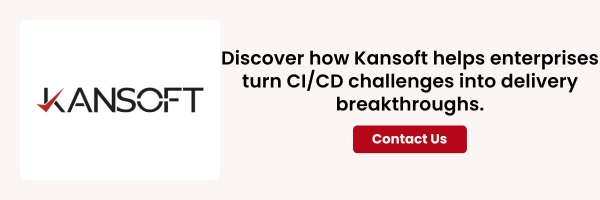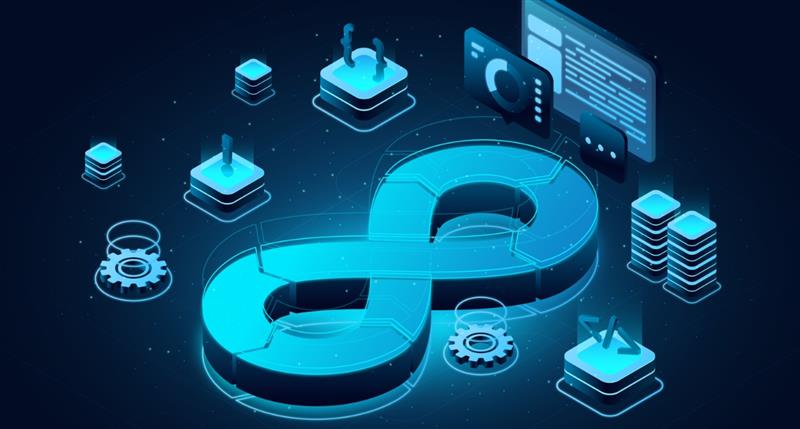In the enterprise world, speed is strategy. Whether you’re rolling out new digital products, updating mission-critical systems, or scaling innovation across teams, your delivery velocity defines competitiveness.
Yet for many enterprises, the faster they move, the slower they deliver. Release cycles drag. Testing queues pile up. Teams lose track of what’s live versus what’s waiting for approval. The result? A growing gap between business ambition and delivery capability.
This is where CI/CD pipelines—continuous integration and continuous delivery—become the bridge. Far beyond simple automation, they represent a new way of working: one that replaces manual friction with seamless flow. According to BrowserStack’s guide on CI/CD challenges, environment inconsistencies and fragmented automation are among the top reasons for failed builds and delayed releases.
At Kansoft, we’ve seen how the right CI/CD foundation turns delivery from a reactive function into a proactive differentiator. But before understanding how CI/CD pipelines help, it’s essential to identify what’s standing in the way.
The Hidden Cost of Bottlenecks
Most enterprise software delivery models still rely on outdated structures—separate teams, manual approvals, and disjointed tools. Each handoff introduces latency, context loss, and risk.
Even with modern tooling, the inefficiencies persist:
- Environmental mismatches cause failed deployments.
- Manual testing delays feedback loops.
- Fragmented toolchains create blind spots.
These aren’t just operational issues; they are strategic blockers. Every delay in pushing a product live means slower innovation, higher costs, and lost market momentum.
To move faster, enterprises need visibility, consistency, and confidence—and that’s what a well-architected CI/CD pipeline delivers.
-
Environment Inconsistency: The Silent Saboteur
Few things derail delivery as quietly as environment inconsistency. A build works perfectly in staging but breaks in production due to missing dependencies, outdated libraries, or configuration drift.
These differences multiply across teams and environments, wasting hours in debugging and rollbacks.
How CI/CD Pipelines Solve It
- Infrastructure as Code (IaC) ensures environments are version-controlled and reproducible.
- Containerization (Docker, Kubernetes) provides environment parity from development to production.
- Automated provisioning allows identical environments to spin up in minutes.
The “build once, deploy everywhere” approach eliminates configuration chaos. With consistent environments, releases become predictable—and recovery faster when something fails.
-
Inefficient Test Data Management
Testing is only as good as the data behind it. Many organizations still rely on static, outdated, or noncompliant test data. QA teams wait days for datasets, and developers can’t validate features until data arrives.
The result: delayed testing cycles and fragile releases.
How CI/CD Pipelines Solve It
- Automated data generation and masking ensure every test run starts with relevant, compliant data.
- Data versioning preserves reproducibility, making results consistent across test runs.
- Synthetic datasets enable secure testing without exposing real customer information.
By integrating test data provisioning directly into CI/CD pipelines, enterprises achieve full-cycle automation—from code commit to validated release, without bottlenecks. 
-
Manual Approval Gates and Slow Feedback Loops
Manual approvals were once considered necessary control points. Today, they’re often the biggest speed bumps.
Waiting for emails, sign-offs, or test summaries halts momentum. Developers lose context, defects multiply, and releases stagnate.
How CI/CD Pipelines Solve It
- Automated quality gates run unit tests, code checks, and security scans in real time.
- Instant feedback dashboards notify developers of issues as soon as they occur.
- Continuous monitoring brings real-world performance data back into the pipeline.
Fast feedback loops create fast learners. When teams receive results in minutes, they fix faster, ship faster, and learn faster—building a culture of continuous improvement.
-
Fragmented Toolchains and Poor Integration
Enterprises often use a patchwork of tools: GitHub for source control, Jenkins for builds, Jira for tracking, SonarQube for quality checks. Each solves a piece of the puzzle—but without integration, they create more complexity than clarity.
Disjointed workflows mean duplicated effort, missed dependencies, and limited visibility into overall pipeline health.
How CI/CD Pipelines Solve It
- Unified orchestration connects every stage—build, test, deploy, and monitor—into one continuous flow.
- Centralized logging gives teams a single source of truth for every run.
- Toolchain interoperability eliminates silos between dev, QA, and ops.
With an integrated CI/CD ecosystem, delivery becomes a synchronized effort rather than a series of disconnected steps.
This holistic visibility empowers leadership to measure velocity, reliability, and deployment frequency—metrics that define modern software success.
-
Suboptimal Pipeline Performance and Scalability
Even with automation, performance bottlenecks often lurk inside pipelines themselves.
Long build times, sequential testing, and limited scalability lead to idle teams and delayed releases.
The irony? The very system designed to speed things up can become the slowest link in the chain.
How CI/CD Pipelines Solve It
- Parallelization and caching reduce build time significantly.
- Cloud-native runners auto-scale resources based on workload.
- Continuous pipeline monitoring highlights inefficiencies and failure patterns.
A high-performance pipeline isn’t just faster—it’s smarter. It adapts to demand, scales intelligently, and delivers insights that drive further optimization.
Organizations that prioritize pipeline performance experience a cascading effect: faster deployments, higher morale, and stronger business agility.
From Automation to Strategy: Rethinking CI/CD for Enterprises
True CI/CD transformation isn’t just about automation—it’s about alignment.
A resilient CI/CD strategy harmonizes people, process, and platform. It moves delivery from a technical function to a business differentiator.
What a Mature CI/CD Strategy Looks Like
- Visibility across the lifecycle: Dashboards that measure DORA metrics—deployment frequency, lead time, failure rate, and recovery speed.
- Security integrated early: DevSecOps practices embed scanning and compliance directly into pipelines.
- Continuous feedback: Production telemetry feeds back into development for faster iteration.
- Optimization as culture: Pipelines evolve through constant measurement and refinement.
- Cross-team collaboration: Developers, QA, and operations align on shared outcomes, not isolated tasks.
When CI/CD becomes an organizational mindset, delivery turns from a bottleneck into a growth engine.
The Business Impact of CI/CD Maturity
For enterprises, CI/CD is more than a DevOps initiative—it’s a competitive advantage.
Organizations with mature pipelines consistently outperform peers in speed, quality, and reliability.
Key Outcomes
- 60–80% reduction in release time.
- Higher quality through automated testing and static analysis.
- Lower operational cost via reduced manual intervention.
- Increased developer satisfaction as tedious tasks disappear.
A global enterprise Kansoft partnered with reduced deployment time from four days to under six hours through CI/CD transformation. The change didn’t just accelerate delivery; it reshaped collaboration across development, QA, and operations—turning delivery into a shared success metric.
From Bottlenecks to Breakthroughs
Every enterprise faces delivery bottlenecks. But with the right CI/CD foundation, those constraints can become catalysts for innovation.
Environment inconsistency, test data chaos, manual approvals, fragmented toolchains, and sluggish pipelines—all can be dismantled through automation, visibility, and cultural alignment. Insights from LambdaTest’s 2025 report emphasize continuous testing, environment stability, and cost management as key focus areas for enterprise-grade CI/CD success.
The payoff isn’t just speed, it’s confidence. Confidence to release faster, respond quicker, and innovate continuously.
At Kansoft, we believe in building delivery ecosystems that scale with ambition. Because when delivery flows seamlessly, teams don’t just ship software—they shape the future of enterprise innovation. 


